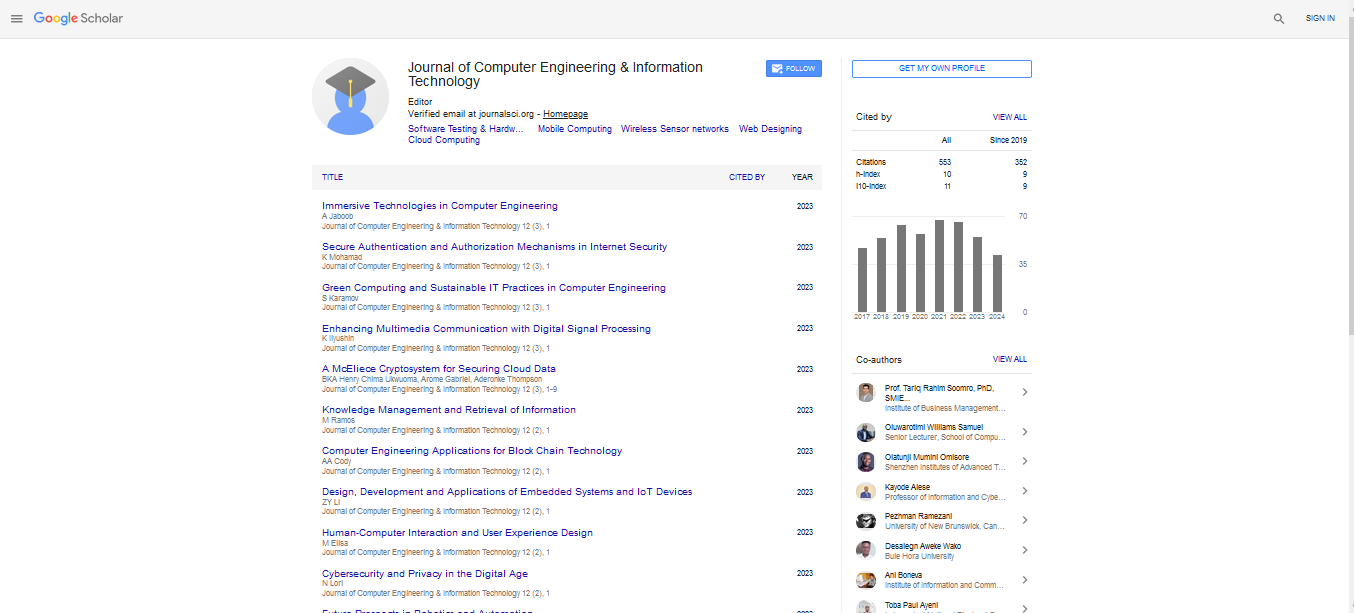Editorial, Jceit Vol: 14 Issue: 1
Docker Containers: Revolutionizing Software Development and Deployment
Rose Kim*
Institute of Human-Centered Computing, Inha University , Inha-ro, Michuholgu, Incheon, Republic of Korea
- *Corresponding Author:
- Rose Kim
Institute of Human-Centered Computing, Inha University , Inha-ro, Michuholgu, Incheon, Republic of Korea
E-mail: kim@ rose.kr
Received: 01-Jan-2025, Manuscript No. jceit-25-169310; Editor assigned: 4-Jan-2025, Pre-QC No. jceit-25-169310 (PQ); Reviewed: 20-Jan-2025, QC No jceit-25-169310; Revised: 27-Jan-2025, Manuscript No. jceit-25-169310 (R); Published: 31-Jan-2025, DOI: 10.4172/2324-9307.1000333
Citation: Rose K (2025) Docker Containers: Revolutionizing Software Development and Deployment. J Comput Eng Inf Technol 14: 333
Introduction
Modern software development demands speed, consistency, and flexibility. As applications become more distributed and complex, developers and operations teams need tools that simplify building, shipping, and running applications across environments [1]. Docker, a platform based on containerization, has emerged as one of the most transformative technologies in this space.
Since its release in 2013, Docker has become a cornerstone of DevOps and cloud-native development, enabling teams to streamline application delivery and improve resource efficiency. Containers package applications and their dependencies into isolated units, ensuring they run identically in development, testing, and production environments. This consistency reduces bugs, accelerates development cycles, and fosters innovation.
Docker is more than just a tool—it is a new way of thinking about software deployment.
What Are Docker Containers?
Docker containers are lightweight, portable, and self-sufficient software units that include everything needed to run an application: code, runtime, system tools, libraries, and settings. Unlike virtual machines, containers share the host operating system's kernel [2], making them faster to start and less resource-intensive.
Key benefits of Docker containers include:
- Portability: "Build once, run anywhere" becomes a reality. Applications in Docker run the same across development laptops, on-premise servers, and cloud environments.
- Isolation: Containers isolate applications from one another and from the host system, reducing conflicts and improving security.
- Scalability: Containers can be quickly replicated and scaled horizontally to meet demand.
- Efficiency: Containers use fewer resources than virtual machines, enabling higher density deployments.
With these advantages, Docker has fundamentally changed how teams approach software architecture and operations.
Use Cases Across Industries
Docker is widely adopted in both startups and enterprise environments across various sectors:
- Software Development: Developers use Docker to create consistent environments, enabling smoother collaboration and integration [3].
- Continuous Integration/Continuous Deployment (CI/CD): Docker is central to automated pipelines, ensuring reliable testing and deployment.
- Cloud-Native Applications: Containers form the backbone of microservices architectures, which are commonly deployed on platforms like Kubernetes.
- Legacy Modernization: Organizations containerize older applications to enhance portability and performance without rewriting code.
- Education and Testing: Educators and QA teams use Docker to spin up disposable, isolated environments quickly and efficiently.
By enabling a modular and flexible approach to application design and deployment, Docker has become essential in digital transformation initiatives.
Challenges and Considerations
Despite its advantages, Docker comes with its own set of challenges:
- Security: Misconfigured containers can introduce vulnerabilities. Running containers with root access or using outdated images can be risky [4].
- Persistence and Storage: Managing stateful applications and data storage in containerized environments requires careful planning.
- Networking: Complex containerized applications may require advanced network configurations that can be difficult to manage.
- Learning Curve: Teams new to containerization must invest in training and process changes to fully benefit from Docker.
Additionally, Docker's role is evolving, particularly in the context of Kubernetes, which has become the standard for container orchestration. In 2021 [5], Kubernetes deprecated direct support for Docker as a container runtime (though Docker images remain compatible), signaling a shift in how Docker fits into the broader ecosystem.
The Future of Docker and Containerization
Docker continues to evolve alongside cloud-native and DevOps practices. Its impact is seen not only in development environments but also in production systems and large-scale cloud deployments.
Emerging trends include:
- Container Security Solutions: Tools like Docker Scout and external scanners are addressing growing concerns around vulnerabilities in container images.
- Integration with DevOps Tools: Docker works seamlessly with popular tools such as GitHub Actions, Jenkins, and Terraform.
- Edge Computing: Lightweight containers are being used to deploy services at the edge, from smart devices to autonomous vehicles.
- Serverless and FaaS Models: Containers serve as the foundation for many serverless platforms, enabling fast and isolated function execution.
As the ecosystem matures, Docker remains a vital part of modern application development—especially when used in tandem with orchestration, automation, and continuous delivery practices.
Conclusion
Docker has transformed the way software is developed, tested, and deployed by introducing a standardized, efficient, and portable environment for applications. Its influence spans across industries, supporting innovation and reducing the friction between development and operations teams.
Despite some challenges, the advantages of Docker—speed, consistency, scalability, and flexibility—are too significant to ignore. Whether used alone or as part of a broader cloud-native stack, Docker is a key enabler of modern software practices. As technology continues to evolve, Docker’s principles of modularity and portability will remain foundational to the future of computing.
References
- Merkel D (2014) Docker: Lightweight Linux containers for consistent development and deployment. Linux Journal 2014.
- Docker, Inc. (2024). What is a container?
- Red Hat (2023) Docker vs. Podman: Whatâ??s the difference?
- Kubernetes Documentation. (2021). Dockershim Deprecation FAQ.
- IBM. (2023). A complete guide to containerization.
Indexed at, Google Scholar, Crossref
Indexed at, Google Scholar, Crossref
Indexed at, Google Scholar, Crossref
Indexed at, Google Scholar, Crossref
 Spanish
Spanish  Chinese
Chinese  Russian
Russian  German
German  French
French  Japanese
Japanese  Portuguese
Portuguese  Hindi
Hindi 